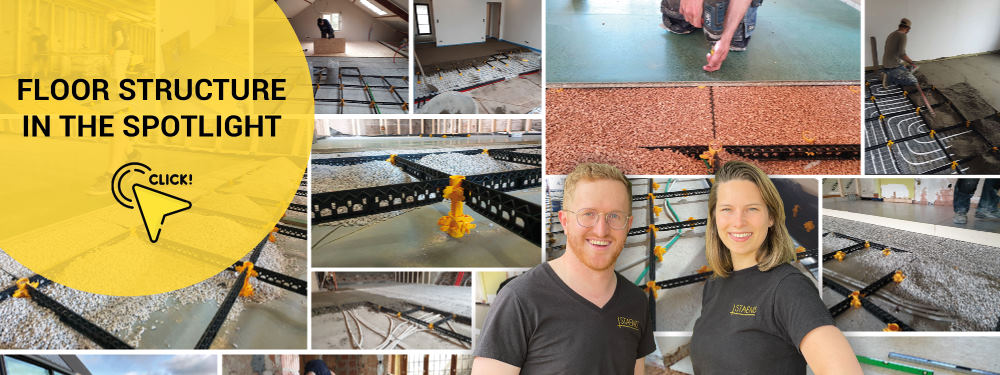Step-by-step screed installation with the Staenis grid Complete manual


Step 1
Of course, it is recommended to start on the flattest possible surface. On the construction site, this is not always evident. Nevertheless, it is advisable to respect the flatness as much as possible. If sprayed PUR has been applied, it must first be sanded flat.
Note: the standard grid can accommodate a height difference of 4.5 cm; it can be adjusted between 4.5 and 9 cm. Therefore, it is important to first check the highest and lowest points of the screed/subfloor. Also, review the complete floor structure and determine the height of the finished floor. This way, you can be sure that the thickness of the screed can always be maintained with the StaenisGrid.
For more than 9 cm, you must first install a leveling layer with screed or insulation screed. On top of that comes a screed with Staenisrooster.

Step 2
You can ensure that the water and electrical pipes are not fully anchored to the concrete floor. This way, it is still possible to move a pipe during the installation of the screed and place a leg at that location. For underfloor heating, the underfloor heating pipes are fixed just tightly enough so that they cannot move, for the same reason.
The slats can be cut at any time, with a saw or grinder, to allow pipes to pass through. Always leave 1.5 cm from the top of the slat, as the grid also serves as reinforcement.

Step 3
Ensure as few overlaps as possible when installing the utilities. If this does occur, you can first provide a leveling screed. This way, you achieve an even thickness of the screed and thus higher quality.

Step 4
Ensure that all connections to the walls with the screed are possible. Ideally, these should be deeper than the plasterwork and perfectly vertical. If this is not yet in order, it is recommended to chip this off before you can proceed to the next step.

Step 5
It is important to start with a clean surface. Objects such as nails, sharp objects, etc. can injure you during the screeding itself.

Step 6
Always provide two layers of plastic just below the screed. This protects the insulation from moisture, preventing it from losing its insulating performance. The plastic layer will also ensure that the screed can minimally slide over the insulation during expansions due to temperature differences or shrinkage.
Tip: If necessary, attach the plastic to the walls with tape or a small nail for smooth installation.

Step 7
Place expansion tape, with a height greater than the screed thickness itself, around the walls. This is cut off after the floor finish has been installed. Some expansion tapes include a self-adhesive part, others are still attached with tape, but not with a nail. This could prevent the expansion and contraction of the screed.

Step 8 (if screed with underfloor heating is present)
Place the underfloor heating on top of the plastic layer with a spacing of 10 to 15 cm. Provide one circuit per 10 m². Carry out the installation and connection of the underfloor heating according to the manufacturer's technical data sheet.

Step 9 (if screed with underfloor heating is present)
If a leg happens to end up directly on top of a floor heating pipe, this is not a problem at all. You can place the leg perfectly on the floor heating pipe; of course, the adjustment screw will need to be screwed back in much further compared to the other legs.

Step 10
Determine the place where you will start screeding. It is best to start at the farthest point from an opening and do this parallel to the wall. Try not to trap yourself in a corner of a room.

Step 11
Place the laser in a location where it is not, or is minimally, in the way, so that you cannot bump into it or accidentally move it. If necessary, place some screed under the laser leg to prevent bouncing or vibrations from insulation. Also make sure that you have to move the laser as little as possible, because every time you move it there will be a small deviation in your level. First, level the laser device yourself, then set it to the correct height and let the device self-level. Determine one or more reference points (take into account the height of the finished floor) and perform a check in various places.

Step 12
You have several options for using a laser. It can be a handy tip to work with a wooden block. Two wooden blocks placed perpendicular to each other (very easy to make yourself). You determine your reference line and place it on the wooden block. In other words, if the line on the wooden block and the laser line are perfectly aligned, then the bottom of the wooden block is the top of your screed.

Step 13
Protective clothing: knee protection is essential when installing a screed, as screed material that comes into prolonged contact with the skin can cause burns.
Protective clothing: gloves that are moisture-resistant are important to avoid all contact between the screed material and the skin as much as possible.

Step 14
Provide yourself with good tools to carry out the screed work as smoothly as possible. Such as a screed bar, knee pads, gloves, laser, spirit level, screwdriver, long screed iron (60 cm, 1.8mm thick), large plastic float, trowel, shovel, bucket, wheelbarrow, mixer, tub, folding ruler, pencil.

Step 15
Click the slats and legs together and build 1 or 2 rows with them. Start in the chosen corner, where you want to begin screeding, with a double row of grids, parallel to the wall. Try to place the grid as straight as possible by eye. This will make it easier to work.

Step 16
If the space is narrower than 110 cm, for example in a hallway, it is recommended to place a full grid (50 x 50 cm) centrally and shorten the slats on the left and right sides. This way, you always have two guides to screed on. This allows you to work more efficiently and the flatness can be better guaranteed.

Step 17
Almost no room will perfectly match the lengths of the slat. That is why the slat can always be shortened to any length with a handsaw. The slat can also be broken by snapping it over your knee or with a cutting disc.
Note: make sure you have the necessary knee and eye protection!

Step 18: Standard click system
This is used to create standard compartments of 50 x 50 cm and ensures a strong connection.

Step 19: Click system side plank
This allows a shortened slat to be supported by a leg.

Step 20: Click system end side of slat
This creates a connection between the shortened slat and the connecting slat. As a result, two shortened slats support each other so that they remain nicely upright while screeding. Tip: the foot only clicks in one direction.

Step 21: Corner connection
In a corner, you may omit two slats and one leg as long as the compartment or division does not exceed 60 cm x 70 cm. The two walls provide the division for the screed. This allows you to save on materials while still delivering a high-quality screed.

Step 22: Wall connection
As described in the previous step, the wall divides the screed, and you do not need to place unnecessary battens parallel to the wall. However, it is still recommended to connect two legs with a connecting batten.

Step 23: Connection of object to/in the wall
Fit the grid as closely as possible to the walls.
Note: make sure that the compartments do not exceed 60 x 70 cm.

Step 24: Connection point in the middle of the room
Place the slats as close as possible to the object in order to create subdivisions again and reinforce the screed.
Note: do not forget to place expansion tape around all objects in the room. Fit the battens as closely as possible.

Step 25
Connection to an expansion joint: Place the grid as you would when connecting it to a wall, but without connecting slats. Up to 200 m², no expansion joints need to be installed in the screed. However, as soon as the passage is less than 110 cm, an expansion joint is required. It is best to install an expansion joint with an expansion strip that you place upright between two grid surfaces.

Step 26
Adjust the grid height with a screwdriver (Tip: wooden block). If sprayed PUR or an acoustic mat is used as a substrate, first place the initial screed material in the grids, then adjust the height to avoid sagging during screeding. Turn the foot upwards using a screwdriver. This can be done with either a Phillips or flathead screwdriver, or with an Allen key. Repeat this step each time to further adjust the grid height.

Step 27
Ensure that the StaenisGrid fits as closely as possible against the wall everywhere. There may be a maximum of 5 cm of space between the StaenisGrid and the wall. This is also the distance allowed to possibly compact the sides with your foot. Do this only at the sides against the wall. Do not compact the screed with your feet in the grids, as this can cause the grid to be pressed into the underlying insulation, resulting in height differences.
Note: As soon as you exceed this maximum dimension, curling of the screed may occur again!
Step 28
- Place excess screed in the grid.
- Note: always handle the first row of grids with great care, as they are still loose.
- Distribute and compact the screed evenly.
- The compressed screed protrudes above the grid.
- Take a straightedge and level the screed at the top of the grid.
- Lightly sprinkle screed and polish so that all holes are rubbed closed.
- After placing a double row, click on a row of slats again and repeat the previous steps.
- For good adhesion strength to the floor finish, it is recommended to go over the screed one last time with a screed trowel of at least 50 cm in length.

Step 29
If you wish to split the screed work over several days, it is recommended to already click in the next row of slats. If screed remains in the click system, this may result in the click system no longer working once the screed has dried.
Note: Try to finish as much as possible per compartment. The photo gives an indication of clicking in the next slat, not of the finishing per compartment.








